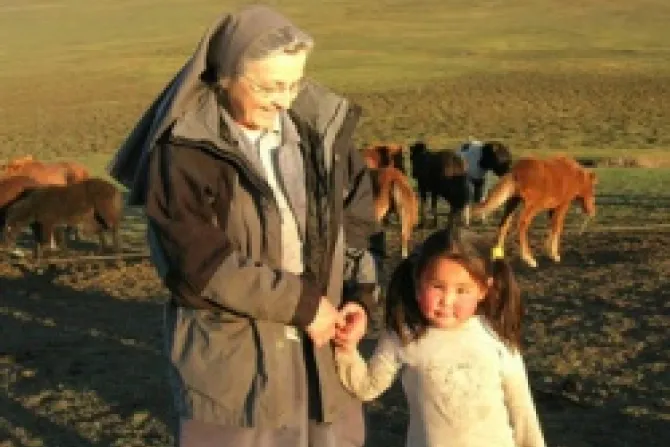Ulaanbaatar, Mongolia, Aug 7, 2013 / 23:05 pm
The Consolata Missionaries have been in Mongolia for ten years, evangelizing a people searching for God and helping improve their lives in a land where more than 20 percent live on less than $1.25 a day.
"People here naturally have been searching for God and looking for meaning to their way of life," Sister Sandra Garay, an Argentine member of the Consolata Missionaries serving in Mongolia, told CNA Aug. 7.
Mongolia was a satellite state of the Soviet Union until the collapse of communism, and 39 percent of its population is non-religious.
The Consolata Missionaries have a "fervor of evangelization," Sr. Garay said, adding that the community is celebrating a decade of their presence in Mongolia, bringing the consolation of Mary to those in spiritual and material need.
The community is one of religious priests and sisters consecrated to God for the evangelization of peoples, especially wherever the Gospel is not yet known. It was founded in 1901 by Blessed Giuseppe Allamano.
Their mission in Mongolia "started from scratch," Sr. Garay said, "and it's a new beginning in the pastoral mission of Mongolia."
"It is a difficult terrain, but God works wonders. And the Year of Faith encourages a hope for our people."
The first Catholic mission to Mongolia was that of John of Pian of Carpine, a Franciscan sent by Innocent IV in 1245. That mission failed, as did one in the following decade.
The first modern mission to Mongolia was the establishment of a mission in the capital city, Ulaanbaatar, in 1922, entrusted to the Congregation of the Immaculate Heart of Mary.
But a People's Republic was set up two years later under Soviet influence, and religious expression was suppressed until the communist government's fall in 1992.
A little over half the population is Buddhist, and most of the remainder is non-religious. Islam, shamanism, and Christianity have mere footholds among the people.
In 2002, the Ulaanbaatar mission was elevated to a prefecture apostolic. The prefecture covers the entire country, and the mission's superior, Fr. Wenceslao S. Padilla, a priest of the Immaculate Heart Congregation, was appointed prefect.
He was consecrated a bishop in 2003. Bishop Padilla oversees the 13 religious congregations which have more than 80 missionaries serving in Mongolia.
Sr. Garay said the nation of 2.9 million has about 1,200 Catholics, 870 of whom are native Mongolians.
The Church encounters tremendous challenges there, in a nation covered by steppes, which experience frigid winters. Nearly half the country's people live in Ulaanbaatar, and many of the rest are nomadic.
Sr. Garay explained that "naturally, coming from a different climate, culture, language and topography, initially it was tough."
"But as a missionary, God takes control and we get adapted."
She concluded on a hopeful note, saying, "we shall continue the pastoral plan of evangelization in welcoming people searching for God and empowering them with education and fostering basic needs."


